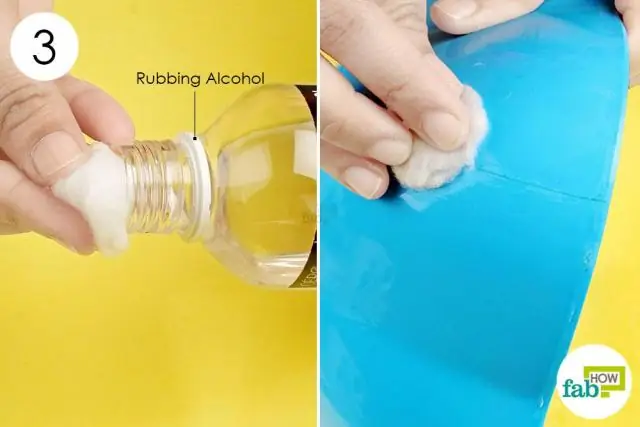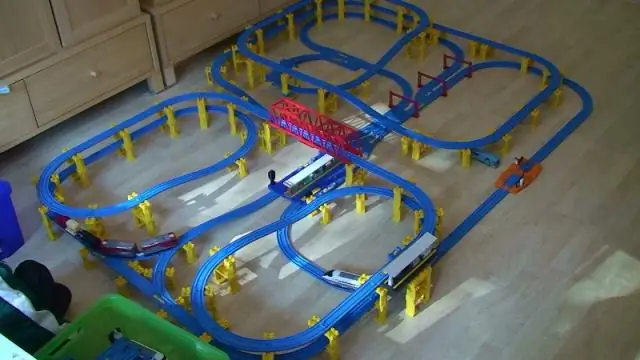
Table of contents:
- Author Bailey Albertson [email protected].
- Public 2023-12-17 12:53.
- Last modified 2025-01-23 12:41.
If the glue is not great: how to wipe off glue spots on plastic and plastic

When using glue like "Super", "Second", and any other, no one is insured against accidental stains. And if a drop hits a plastic surface, getting rid of it can be a real problem. To quickly and effectively wipe the stain without damaging the plastic, you need to know how to do it correctly.
Content
-
1 Why is it so difficult to remove adhesive residues from plastic
-
1.1 Which traces can be easily removed and which not: types of glue
- 1.1.1 Superglue, Seconds, Cosmophen - cyanoacrylates with a really second setting
- 1.1.2 BF - medical glue that can be dissolved with alcohol
- 1.1.3 Moment - actually dries up for a long time, and this is a plus
- 1.1.4 PVA - you can remove it by washing or rolling
- 1.1.5 Titanium is difficult to clean
-
-
2 Means and methods for removing fresh and dried glue
- 2.1 Anticlea
- 2.2 Water
- 2.3 Soap solution
- 2.4 Oil
-
2.5 Acetone
2.5.1 Video experiment: how acetone dissolves plastic
- 2.6 Alcohol
- 2.7 Gasoline
- 2.8 Automotive or household windshield wiper
-
2.9 Dimexide
2.9.1 The use of Dimexide to remove the glue spot - video
- 3 What not to do
Why is it so difficult to remove adhesive residues from plastic?
Adhesives vary in scope and composition. There are water-based adhesives with the addition of acetone, alcohol and other solvents. Some are similar in composition to plastic and are difficult to remove from plastic surfaces.
Some stains require the use of aggressive solvents, which leave marks and discolored stains on the plastic. And the composition itself, intended for gluing plastic, can partially dissolve the surface. After removing the stain, damage will remain on it. That is why it is advisable to remove the trace as soon as possible.
Several methods and means for removing glue are also dangerous for plastic. Solvents that can dissolve it will do the same with plastic.
The application of this or that method depends on the composition of the glue, the surface from which it needs to be removed and how long it has been on it.
Which traces can be removed easily and which not: types of glue
Consider briefly the most popular of the many manufactured by the industry.
Superglue, Sec, Cosmophen - cyanoacrylates with a really second setting
Despite the different names, they have a similar composition and principle of action.

The main active ingredient of superglue is cyanoacrylate
The main active ingredient is cyanoacrylate. The composition does not contain solvent, its curing occurs under the influence of water and oxygen in the glued surfaces. When frozen, it is similar to plastic.
It can be removed with acetone, dimexide, anti-glue, mvlny solution. For plastic, it is better to use anti-glue or soapy water, they will not damage the surface.
BF is a medical glue that can be dissolved with alcohol
BF adhesives contain synthetic resins and rosin dissolved in alcohol.

Alcohol will help to remove BF glue stains, since it is part of the glue
Resistant to oil, kerosene, gasoline, acids. Since it contains alcohol, it is also used to remove stains.
Moment - actually dries up for a long time, and this is a plus
This is a whole group of adhesives, depending on the additives, each of them is designed for a specific purpose.

Different forms of glue Moment have a similar composition
It has a complex composition, including rubber resins, rosin, ethyl acetate, acetone as a solvent. Stains are best removed with acetone and dimexide.
PVA - can be removed by washing or rolling
Emulsion of polyvinyl acetate in water, refers to water-soluble adhesives.

Fresh spots of PVA glue can be easily removed with water
Surfaces that do not absorb water, including plastics, do not bond well. This makes it easier to remove stains from plastic surfaces. A fresh stain is easily washed off with water, a dried one is enough to scrape or pry off the edge and pull, removing the film. It lends itself to almost all solvents, including acetic acid.
Titanium is difficult to clean
Refers to persistent and difficult to remove. Composition - styrene-acrylic dispersion. Dissolves with concentrated acid for plumbing, gasoline, dimexide.

Glue Titanium is one of the most resistant and harmless
Adhesives containing aggressive solvents such as acetone or white spirit can leave discolored spots on plastic, matte areas or cavities on a glossy surface, and traces of damage to the plastic.
To avoid the effects of the glue on the plastic surface, remove the stain as soon as possible.
Means and methods for removing fresh and dried glue
To begin with, it is useful to find out the composition of the glue. The success of using this or that remedy to remove it depends on this. General rule: delete like like.
Anticleus
The glue manufacturers have also taken care of the glue remover. Use a product from the same manufacturer as the adhesive, it may be less effective with other brands.

For effective adhesive removal, use a professional product.
When using the product, follow the instructions on the package. Keep in mind that the composition is toxic, use it only in a well-ventilated area, work with gloves, and avoid contact with eyes.
According to user reviews, the Secunda anti-glue is effective against most adhesives, including those based on cyanoacrylate, and of various ages. It practically does not damage plastic surfaces. But before use, do the test on an inconspicuous area.
Water
With its help, fresh spots of stationery, carpentry, vegetable and polyvinyl acetate-based glue are removed. Gently blot the stain, remove the rest with a damp cloth. Water will not cope with dried spots, with the exception of water-soluble PVA.

Fresh glue stains can be removed with a damp cloth or sponge
A dried PVA stain will not dissolve with water, but will only soften. After that, it is easy to remove it mechanically - by rubbing it with a hard sponge or eraser. Then treat the surface with a degreasing solution or wash off with soapy water.
Soap solution
Non aggressive and safe for the surface. It will soften the top layer of adhesive, which is then removed mechanically.

The soap solution is not aggressive, but will not remove any glue stain
Removing the stain will require multiple soaking and layer-by-layer removal, which will take a lot of time. Suitable for cyanoacrylate based adhesives.
Oil
Vegetable oil in some cases will also help clear glue stains from plastic. Moisten the stain liberally and leave it on for a while. The adhesive layer will soften and it will be possible to clean it off. The oil is non-corrosive and can be left on the surface to soften overnight.

Vegetable oil is used to remove glue stains
After processing, degrease the surface by wiping with alcohol or soapy water.
Vaseline has a similar effect.
Acetone
Suitable for removing super glue, Moment glue and nitrocellulose glue. Instead of acetone, a nail polish remover containing this solvent is used. Treat the stain with a cloth soaked in solvent and wait 15 minutes. Then repeat the treatment, the stain can be easily removed.

Acetone is one of the most effective glue removers
When working with acetone, keep in mind that it dissolves paints and cellulose-based plastics. Test on an inconspicuous area before using this method.
Video experiment: how acetone dissolves plastic
Use acetone only as a last resort and making sure the surface is resistant to its action.
Alcohol
Alcohol is suitable for removing BF glue, as it is part of it.

Ethyl alcohol can be purchased at the pharmacy
It will also help remove superglue. Its alcohol will not dissolve, but will make it viscous, after which the residues are removed mechanically. Rub the stain with a hard cloth or eraser, rinse off the rest with water.
Petrol
Aviation or regular gasoline will remove gum stains. Treat the stain with a rag soaked in gasoline. If the stain cannot be removed immediately, moisten it generously and let sit for a few minutes.

Highly refined gasoline is used for refueling lighters, sold in small bottles
Gasoline and kerosene are also used to remove glue stains of unknown origin. Both of these funds are considered universal.
Car or household windshield wiper
If nothing else is at hand, you can use a glass cleaner. Typically, these liquids contain alcohol, and for some adhesive traces this method may work.

Some adhesives can be removed with a glass cleaner
Moisten the stain liberally with the liquid and wipe with a dry cloth after a few minutes. Repeat as necessary.
Dimexide
Perhaps the most versatile remedy. Apply the product to the stain, being careful not to get liquid on the plastic. Do not leave Dimexide on the surface, with prolonged contact this strong solvent can damage plastic.
Rub quickly with the hard side of a dishwashing sponge or a coarse cloth. After removing the stain, wash the surface with soapy water.

Pharmacy agent Dimexide is a universal solvent for any glue
Use a cotton swab or brush to apply the product, Dimexide can cause burns. Be careful, Dimexide easily penetrates the skin and is able to deliver everything that has dissolved into your body. Protect your hands with rubber gloves, which should be removed immediately after use - Dimexide also dissolves the rubber.
The use of Dimexide to remove glue spots - video
Dimexide dissolves all known adhesives, including strong cyanoacrylate-based superglues.
When choosing a product, pay attention to the ingredients. Try to dissolve the composition that is not moisture resistant with water. If it is not heat resistant, it can be removed with high temperature. In this case, it is important that the plastic itself is heat-resistant.
Do not use an open fire, use a hair dryer or a heated iron with a thick layer of paper underneath.
What not to do
- Do not use a knife or other sharp object to scrape the stain off the plastic, it will scratch it.
- For the same reason, you should not use abrasive products for cleaning if you are not sure that the surface is hard enough.
- When using an aggressive solvent, make sure in an inconspicuous area that it will not damage the surface.
- Do not use anti-glue without taking safety measures: open a window or turn on the hood, put on gloves.
The best way to deal with any stains is to keep them away. Be careful and careful when handling the glue and you will avoid problems with removing stains. And if it does happen, now you know what to do.
Recommended:
How To Wipe Off The Glue From The Adhesive Tape - Remove Traces Of Ordinary, Double-sided, Painting From Plastic, Furniture, Glass, Clothes And Other Surfaces + Photos And Videos

Everyone uses scotch tape, and sometimes unpleasant traces remain after it. How to wipe off adhesive from plain or double-sided plastic, furniture, glass or clothing
How And With What To Wash The Resin From Hands And Other Areas Of The Skin, As Well As Wipe It Off The Hair

How to clean tar from hair, hands and other areas of the body. Ways to cleanse baby and delicate skin, their assessment. Instructions, precautions. Video
How To Remove Glue (super, Moment And Others) From Fingers, Hair And Other Parts Of The Body At Home

How to remove glue from hands, nails, hair, baby skin. What methods and means are used for this. How to remove glue from the skin
How To Wipe Off Super Glue From Various Surfaces And Objects

Superglue composition and properties. The main ways to wipe it off from various materials and from human skin. Instructions with photos, safety precautions. Video
How To Wash Fukortsin From The Skin, As Well As Wipe It Off Various Surfaces And Objects In The House

How and how to remove Fukortsin stains from various surfaces and human skin. Safe ways for children and sensitive skin. Proven recipes
